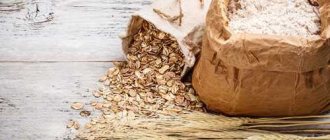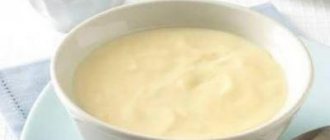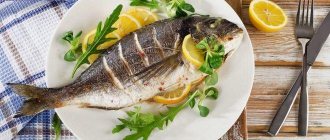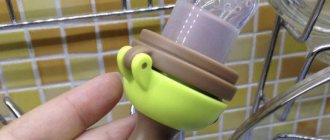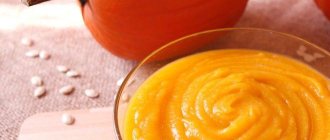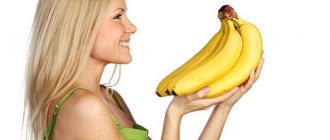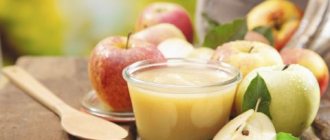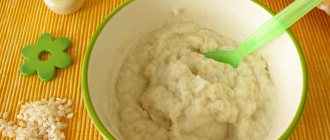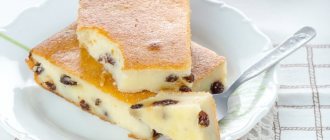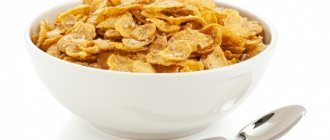The benefits of corn porridge
Corn porridge is rich in fiber, which has a very positive effect on children's intestines. After all, this cereal can fight constipation, rotting and fermentation in the intestines. It has a great effect on the child’s immunity, strengthens the heart muscle and blood vessels, prevents the development of nervous diseases, acts as a mild sedative, and strengthens teeth. Also, do not forget that corn grits do not contain gluten, do not accumulate pathogenic substances, are considered an environmentally friendly crop, are rich in minerals and vitamins, and contain a small amount of carbohydrates. 100 grams of cereal contains only 328 calories, so feel free to eat porridge, it is low in calories. Corn porridge also reduces stomach acidity.
The benefits and harms of corn porridge
The content of iron, B vitamins and magnesium improves the nervous system. Frequent consumption of corn porridge reduces the risk of cardiovascular diseases. A large amount of fiber helps stimulate intestinal motility, as well as cleanse the gastrointestinal tract.
The presence of vitamins A, C, E, K, PP and basic antioxidants increases hemoglobin, improves brain function and memory, has a positive effect on the appearance of the skin, and strengthens hair. People who may be allergic to gluten can eat corn porridge without risk to their health, since it is completely gluten-free.
However, frequent consumption of it can provoke excessive intestinal motility, which may cause slight pain in the abdominal area. For people suffering from intestinal diseases, eating corn porridge is not recommended.
Introduction of complementary foods: Corn porridge
Typically, corn porridge is introduced into complementary foods immediately after buckwheat or rice porridge. The approximate age of a child when corn grits are introduced into the diet is about 8-9 months, however, if complementary foods are introduced earlier than 6 months (WHO recommended age for introducing complementary foods), then the timing may approximately shift. We introduce corn porridge into baby food like any new product, i.e. We make sure to observe a waiting period of 4-7 days to identify an allergic reaction to the product, and also look at the baby’s condition and how his body reacts to the new product. We remind you that for the first feeding of corn grits, it must be ground to the state of flour. And then cook porridge from corn flour. You can use specialized baby food, just keep in mind that corn porridge should be one-ingredient and dairy-free; after introducing it into baby food, you can feed it in this form to the baby with the addition of his favorite fruits. We also exclude any additives for porridge in the form of salt, sugar and various sweeteners, etc. The only thing that can be put in porridge is butter, but again, if it is included in the baby's diet.
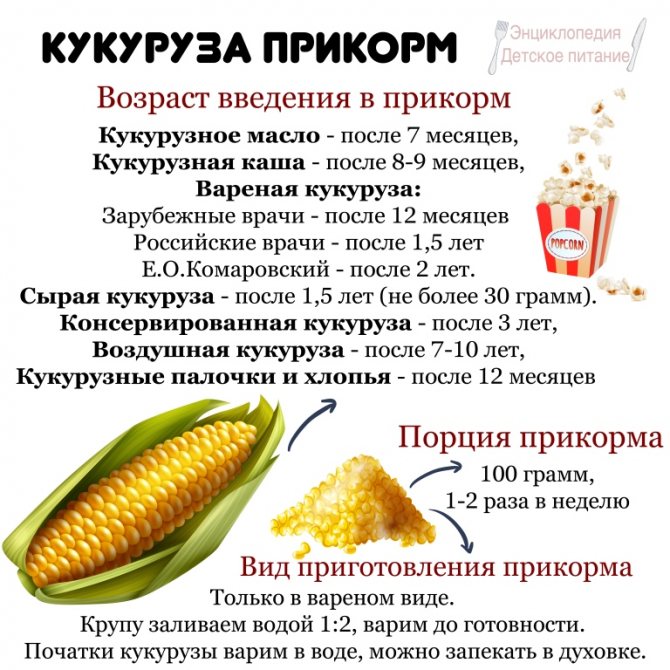
corn complementary food
The best corn porridge for complementary feeding
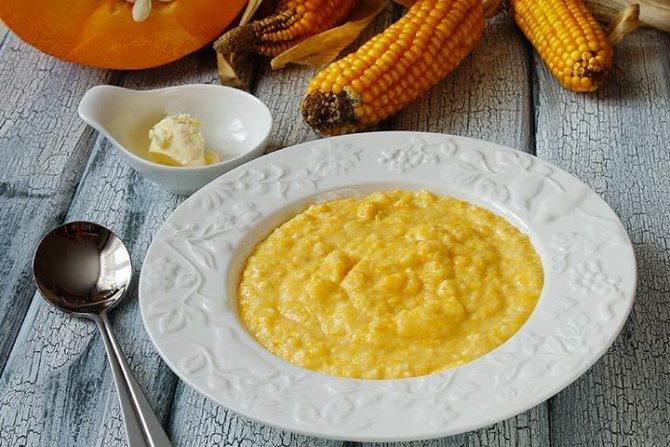
To feed a baby, you can use baby dry instant porridge, corn grits or flour. The mother decides for herself what to choose for preparing complementary foods. But you should consider some advantages of specialized baby cereals:
- Balanced composition and enrichment with vitamins;
- Ease of preparation;
- Availability;
- Optimal consistency.
If the mother decides to prepare complementary foods from cereals or flour, then you need to take into account that you cannot skimp on the quality of raw materials. Cooking meals for your baby yourself has a beneficial effect on the mother’s emotional state, and the dish always turns out delicious.
How to cook corn porridge for complementary feeding?
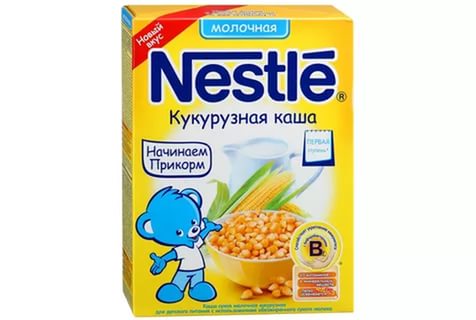
If it is decided that the first complementary food is corn porridge, then how to prepare it correctly is the first question that arises for parents.
Stages of preparing dry baby porridge:
- Wash your hands with soap;
- Prepare clean dishes (separately for the baby);
- Boil water and cool it to 40°C;
- Pour the porridge into the prepared bowl strictly according to the instructions (you can use half the volume to start introducing);
- Stir thoroughly until completely dissolved;
- Adding sugar and salt is not recommended;
- If butter has already been introduced into complementary foods, you can add it according to the norm;
- You can add expressed breast milk or adapted formula;
- Cow's milk should not be used to feed children under 1 year of age.
Stages of preparing porridge from cereals or flour:
- Wash your hands with soap;
- Prepare clean dishes;
- Rinse the cereal thoroughly in water;
- Boil the cereal until tender at the rate of 2 teaspoons. spoons per 100 ml of water;
- The cereal can be pre-ground in a coffee grinder or blender;
- Cool the finished porridge and grind through a sieve or grind with a blender to a creamy consistency;
- You need to add expressed milk only after the porridge has cooled, in order to preserve its beneficial properties as much as possible.
You cannot cook cereals for future use. Each time you need to prepare a new portion, even if it looks and tastes fresh. It is not advisable to heat complementary foods in the microwave due to uneven heating and the likelihood of burning the baby’s oral mucosa.
How to introduce corn porridge into complementary foods?

Principles for introducing corn porridge into complementary foods:
- Given during the daytime (to monitor the child’s condition during the day);
- The first time the volume is 1-2 teaspoons. spoons, increasing to normal within a week;
- Only a monocomponent composition is used;
- You cannot introduce new complementary foods during illness and preventive vaccinations;
- If an attempt is unsuccessful, you can repeat complementary feeding with a new dish up to 10 times, allowing the child to get used to it;
- After the full volume has been administered, you can transfer the porridge intake to the evening;
- You can add juice or fruit puree to a dish only after making sure that the food is well tolerated;
- After feeding, the breast must be offered (to maintain lactation), even if the baby is full.
Complementary feeding with cereal porridges is preferable for children receiving breast milk. This is explained by the similarity of the taste of porridge and milk. Due to its easy digestibility, taste and lack of gluten, corn porridge is excellent for baby's first feeding.
Valentina Ignasheva, pediatrician, especially for Mirmam.pro
How to select and store
Usually, polished corn grits are chosen for home use. It differs in numbers and, accordingly, in grind size. So there are the smallest grains No. 1 and 2, the larger ones - No. 3,4,5. You should not buy extra corn grits; usually old grits are bitter. Before purchasing, you should check the tightness of the packaging and the expiration date. The grain should be uniform, without impurities, debris and mold, the grains should not be stuck together, the color of the corn grits should be yellow, but not very bright. It is necessary to store cereals in a dark, cool place, preferably in a glass or ceramic container, making sure it is sealed so that insects do not get inside the container where the cereal is stored.
It is best to use corn flour, which is ground from cereals, to prepare corn porridge for a child. It is better to grind cereals than to buy corn flour in the store, since the latter contains a large amount of starch, it is higher in calories, it lacks vitamin E and a small amount of B vitamins. Corn flour needs to be ground in a small amount, ideal for one time, but you can and two or three times. Store cornmeal in an airtight container in a dark, dry place.
How to cook?
To properly cook corn porridge and ensure that the maximum amount of nutrients is preserved in the finished dish, you can use a simple recipe for its preparation.
Additionally > Approximate menu for a child at 7 months (Introducing complementary foods)
So, the instructions for preparing porridge are as follows:
- corn grits are thoroughly washed under cold running water;
- the washed cereal is dried;
- dry and washed cereals are ground in a regular coffee grinder or crushed using a blender (for small children) or uncrushed fractions are used for cooking (for older children);
- It is best to cook corn porridge in a non-stick pan, as it can easily burn, thereby spoiling the overall taste of the dish;
- cereal: crushed or whole, placed in a cooking container and filled with hot water or milk, then brought to a boil and cooked for 15-20 minutes over low heat with constant stirring;
- To improve its taste, add a little sugar, fruit puree or sweet fruit, as well as a piece of butter to the finished porridge.
This is not the only recipe. Also today, other methods of preparing porridge are available to modern housewives. For example, it can be prepared in a slow cooker, steamer or oven, which will preserve its beneficial properties as much as possible.
Reading...
At what age can you give goat milk to a baby?
You can diversify your baby’s menu with corn porridge, alternate it with other types of porridge or other complementary foods. This way the child will receive a varied diet, which will also have a positive effect on the development of his taste preferences.
Watch the video recipe
- Related Posts
- Is it possible to start feeding a baby at 3 months?
- How to cook rice porridge for babies and when can it be given to them?
- Approximate menu for a child at 7 months (Introducing complementary foods)
Preparation of complementary foods: Corn porridge
When preparing baby food with corn flour, you need to take 1/4 cup of flour to 1-2 cups of water. Pour corn flour into boiling water, whisk, stirring constantly to avoid the formation of lumps. Cook for 10 minutes. You can add mother's milk to baby corn porridge to achieve a uniform consistency.
Corn grits are usually poured overnight; before cooking, they must be thoroughly washed and filled with boiled water. Pour the cereal 1:2, i.e. one glass of cereal and two glasses of water. After the water has boiled, the heat is reduced and the corn porridge is cooked for about 10-15 minutes, and then infused for the same amount of time. After the heat is turned off and the porridge is salted, butter is added. After preparing this porridge, you can beat it with a blender and milk formula/mother's milk to achieve the required consistency.
Also, corn porridge turns out well when boiled in a multicooker, put all the ingredients in the multicooker bowl and set the porridge mode (depending on which multicooker, maybe the “milk porridge” or just “Buckwheat” mode, etc.), after the signal, let it brew for some time 15 minutes.
We remind you that we add salt and butter to corn porridge if the child is familiar with these products.
How to cook corn porridge for a child
Corn grits are distinguished by their high content of iron and silicon, as well as natural fiber necessary for proper digestion. It helps improve the functioning of the cardiovascular system and strengthens the human immune system. It is often recommended for children who have dental problems. There are many simple recipes for making delicious and healthy corn porridge.
Corn porridge with milk for children
To prepare, you will need the following ingredients: 3 tablespoons of cereal, 1 glass of water, half a glass of milk, a small piece of butter. Rinse the corn grits, add cold water and put on fire. After boiling, you need to cook it over low heat for 20-25 minutes. After this, add milk to the porridge and cook for another 15 minutes. During cooking, you can add sugar to taste. After complete readiness, add 500 butter.
Milk soup with corn grits
Necessary products: 1 glass of corn grits, 400 grams of water, the same amount of milk, 70 grams of butter, sugar, salt to taste. Add milk to a small bowl, wait for it to boil and set aside. Rinse the cereal, add water, salt and bring to a boil in a saucepan. Cook over low heat for 5 minutes, stirring the porridge occasionally. Then add pre-boiled milk to this pan and boil for another 25 minutes, stirring continuously so that the cereal does not stick to the bottom of the dish. Once ready, add butter and sugar to taste into the corn porridge. Serve warm with the addition of fruit or jam.
Porridge with dried fruits
Corn porridge with the addition of dried apricots and prunes will also be useful for the child. To do this, dried fruits must first be kept in boiled water, then cut and only then added to freshly prepared corn porridge. Be sure to cover it well when hot and let it sit for a while. Then you can use it. For 1 cup of corn grits you need 100 grams of dried apricots and 100 grams of prunes.
Corn porridge in the oven
For children after one year, there is another recipe for corn porridge. First, you need to bring the corn grits with water to a boil, then with the lid closed, place in the oven for 25 minutes at a temperature of about 150 degrees. During this time the porridge will become thick. Separately, in another bowl, boil 1 glass of milk and add to the porridge. Mix everything well and return to the oven for 15 minutes. In the cooked, slightly cooled porridge, you can put fruits (according to the children’s taste preferences): bananas, apples, strawberries, cut into small pieces, then a breakfast of corn porridge will be even healthier and tastier. After all, every mother wants her child to eat only nutritious food.
How to cook corn porridge for babies?
In order not to harm the little one, the new dish must be prepared correctly.
Mom has 2 ways to solve this problem:
- buy a ready-made instant product from a well-known baby food manufacturer;
- cook it yourself.
The first method is the simplest - you don’t need to cook anything, just dilute the powder - and that’s it, the porridge is ready. As a quick option when you urgently need to feed a child, this route is quite suitable.
The second way will take longer, but homemade porridge is both healthier and cheaper. In addition, without changing the recipe much, you can get different results.
Recipe No. 1. Corn porridge on water.
Ingredients:
- very finely ground corn flour or grits 6 tbsp. l.;
- water – 0.5 l;
- sugar – 10 g;
- salt - to taste;
- butter or vegetable oil – 1 tsp.
Let's start cooking the porridge.
- Place the pan on the fire. It is important that the water boils, but not boils. Salt the water, add sugar.
- Measure out the required amount of cornmeal or grits.
- While constantly stirring, pour the cereal into boiling water. Reduce heat to low and continue cooking for 3 minutes. Make sure there are no lumps.
- Turn off the heat, put a piece of butter in the pan. Cover with a lid and leave for 10 minutes.
- The porridge has a medium consistency - it will be easy for the little one to swallow.
If there are lumps in the porridge, then it is easy to correct this situation. Rub the finished porridge through a sieve or spin in a blender at high speed.
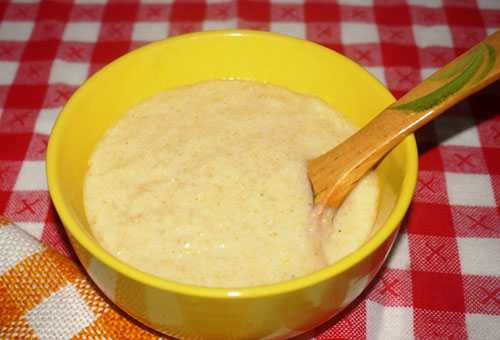
A familiar dish with a new twist
Would you like to cook something new? Replace the water with low-fat chicken or turkey broth and omit the sugar. Cook for the same 3 minutes. Get a higher calorie and richer variation of corn porridge. Add meat puree or a steamed cutlet - and the little one has almost a restaurant dish on the table.
Useful: Recipes for healthy decoctions for infants
Add any vegetable puree to broth-based porridge for a new taste. Replace the water with milk, add fruit puree or garnish with berries or pieces of fruit, and your baby will happily eat every last spoonful.
This recipe is suitable for feeding babies, and adults will appreciate it. Corn porridge for babies is simple, tasty and healthy. And, importantly, mom doesn’t have to have the talent of a chef and a decent amount of free time: if you try, you can prepare the dish during a commercial break in your favorite TV show.
Corn porridge
Your baby will love this tender and surprisingly tasty gluten-free corn porridge. Introduce her into complementary foods at the second stage. First, offer your baby a small portion of a new dish - 1 teaspoon. Corn is a valuable grain in a baby’s diet. Thanks to the significant amount of iron in its composition, as well as the presence of vitamin PP and sodium, corn prevents the development of anemia, promotes the development of muscle function and helps intestinal function.
Corn grains contain up to 61.6% starch, 4.2-4.75% oils, about 100 mg% B vitamins, nicotinic acid, biotin and some minerals, including zinc.
Corn does not contain gluten, which can cause allergies in infants, so corn milk porridge may be one of the first things you introduce to your little treasure during the introduction of complementary foods. However, it is still better to start introducing the baby to rice or buckwheat porridge, as they contain more iron, which is vital for babies over 6 months old. But after your baby has already appreciated his first milk porridge, you can offer him a delicious corn porridge.
Since after your baby is six months old, the vitamins and minerals that he receives from breast milk become insufficient to satisfy the growing needs of his body. This is the right time to start introducing foods of various types and tastes – complementary foods – into your little angel’s diet. Mild vegetable purees are traditionally the baby's first complementary food. When the baby begins to eat a full portion of such complementary foods during feedings, you can gradually move on to the second stage of introducing complementary foods - baby cereals.
Gluten-free corn milk porridge will surely captivate your little gourmet with its pleasant taste. You can prepare it using your own milk or baby formula if the baby is already on mixed feeding. To make your baby’s menu rich and varied every day, you can use a vegetable decoction to prepare the porridge after boiling the vegetables for puree.
To begin with, make the baby’s porridge sufficiently liquid and uniform in consistency. This will make it easier for the baby to swallow it, because before this he was used to drinking only mother’s milk. Start accustoming your little fidget to a new food product gradually. To begin with, offer no more than a teaspoon of porridge to your baby during feeding and give her the usual milk. If your baby doesn’t like the porridge, you shouldn’t force him to eat it. If the baby has tried a new complementary food product, gradually increase its amount to a full portion of 100-150 g per feeding.
When preparing complementary foods for your little gourmet, you should not use sugar, salt, as well as spices and sweeteners in them until he is at least 2 years old.
Industrially produced baby milk and dairy-free porridges will be an excellent helper for mothers at the second stage of introducing complementary foods into the baby’s diet. Their composition is enriched with all the vitamins and minerals a baby needs, so you can be sure that your baby will receive everything to grow and develop correctly.
Has your little fidget tried a variety of porridges from each cereal separately? No problem! Try to pleasantly diversify your little one’s familiar menu with a tasty and healthy multi-grain porridge.
When your baby has teeth, you can gradually switch to a porridge that is thicker and less uniform in consistency, which he could chew on his own, developing new skills. By this time, the baby will already be successfully eating vegetables and fruits in complementary feeding, so in order for him to develop the correct taste sensations and try new combinations in food, you can diversify his daily diet by adding some fruits or vegetables to the familiar porridge and see how Your little champion will react to this.
Try to seat your treasure at the same table with the rest of your family during meals, so that a positive example will help him develop healthy eating skills. Actively involve your baby in the feeding process, give him a spoon so that he not only eats his favorite food with pleasure, but also develops fine motor skills.
Even at an older age, corn porridge with a little butter for taste is ideal as a side dish for steamed cutlets or meatballs. Don't forget that a varied and balanced menu will help your little fidget grow up healthy and full of strength.
How to properly prepare corn porridge for babies
If porridge is cooked for newborn children up to one year old, then the cereal must first be sorted, washed, dried, and then crushed to flour. During cooking, the grain becomes four times larger, so we also pour four times more water (that is, take 2 cups of water per 0.5 cup of crushed grain) and wait until it boils. Add the cereal to boiling water (milk) to preserve all the nutrients, cook for 10-15 minutes, stirring constantly to avoid burning. Let it brew for at least 20 minutes. Porridge made from corn flour turns out to be very soft and tender, without lumps, it is easy for a child to eat.
It is recommended to store the finished porridge in the refrigerator, but not more than 24 hours.
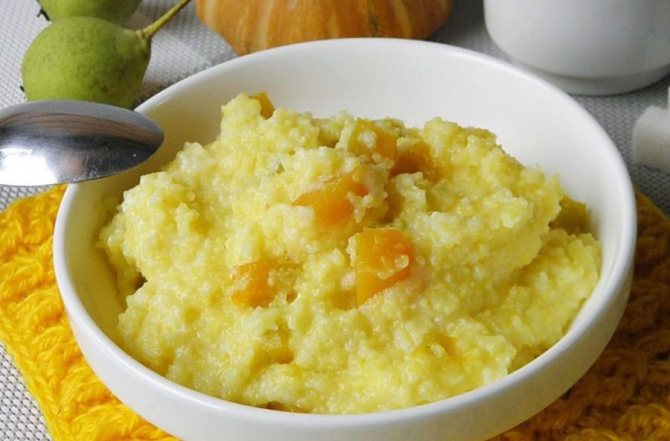
It is advisable to heat it in a water bath, but it is best to cook fresh porridge before each feeding
You can use another recipe for preparation when it is not possible to grind the product. In this case, you need to cook the corn porridge for 35-40 minutes, and then you also need to let it sit under the lid. After which the finished mixture is pureed in a blender.
It turns out incredibly tasty in the oven. To do this, we use a clay pot, pour water, add cereal, salt and put it in the oven, heated to 180 degrees. After 20-25 minutes, stir the porridge, and after 50-60 minutes, remove the pot from the oven.
Knowing how to cook corn porridge for babies in a double boiler and slow cooker, you can get a crumbly dish with a wonderful taste and aroma. Here you will need water and crushed cereals (flour). We cook using the “rice” mode, pour the cereal into the water in a ratio of 1:3. We also add salt, a little butter and sugar.
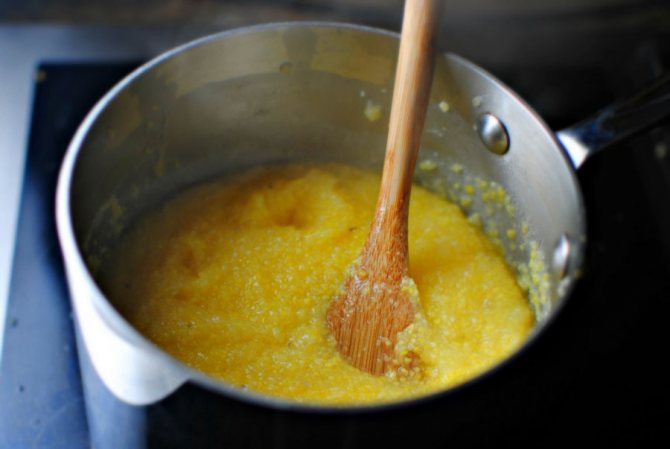
It is undoubtedly recommended to prepare such porridge with water or milk, but if the baby is not yet ready for dairy products, you can also use breast milk. Mom decides how to cook it
